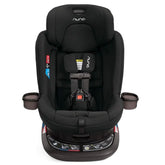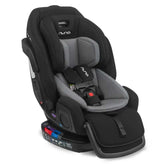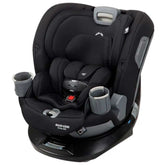How to Effectively Give Nasal Saline Drops to Your Baby or Toddler

If you’ve ever dealt with a congested baby or toddler, you probably know that nasal saline drops are a handy tool to have in your little one’s medicine cabinet. Nasal saline drops are a safe, effective way to dissolve mucus and minimize sinus swelling in children suffering from a cold, the flu, or seasonal allergies. Some brands also contain steroids to help further reduce swelling. Let’s take a look at how baby nasal saline drops work, tips for applying them, and when you might need to call a doctor.
How Nasal Saline Drops Work
Infant nasal saline drops are essentially a concentrated salt water solution that works by osmosis. Osmosis is the process by which molecules of a solvent pass through a semipermeable membrane from a less concentrated solution into a more concentrated one, thus equalizing the concentrations on each side of the membrane. In other words, the concentrated saltwater solution gently pulls moisture out of swollen sinus tissue, making it easier for your congested baby or toddler to breathe. It also helps dilute and soften crusty, dried mucus, making it easier to remove. You'll find a range of high quality, all-natural nasal relief products at ANB Baby.
How to Give Nasal Saline Drops to a Baby
Doctors frequently recommend nasal saline drops for infants and toddlers dealing with nasal congestion due to colds, flu, hay fever, sinusitis, respiratory syncytial virus (RSV), and other uncomplicated upper respiratory conditions. Whether the nasal drops are prescribed or over-the-counter, it's always important to use them according to your doctor's instructions.
Trying to treat a cranky, uncomfortable baby can be tricky so use these steps to get the job done:
- Begin by washing your hands thoroughly with soap and water.
- Use a clean dropper or syringe to siphon out the correct amount. (Dosage information should be available in the manufacturer’s instructions.) Alternatively, some nasal saline drops have a dispenser built-in to the top of the bottle.
- Nestle your baby into your left arm (if you are right-handed). Lean against the arm of a couch or chair, or prop your arm up with a large pillow for a bit of additional support. If your infant is upset or squirming, have another adult assist you. They can help keep the baby's head and hands still.
- Use a nasal suction bulb to gently remove any loose mucus.
- Next, place the dropper just inside the opening of your infant’s nasal passage. Try to avoid actually touching the tip of the syringe to any part of the nose.
- Carefully squeeze the pre-measured solution from the syringe into the baby’s nose. If you need an additional dose of saline drops, ask another adult to help you. If dispensing saline drops directly from the bottle, administer 1 drop in each nostril for babies under 2 years of age.
- Continue to cradle your baby in this position for about five minutes. This allows the saline to begin seeping into their sinus tissue and start loosening and softening the mucus.
- Bring your baby to a vertical position if they begin coughing.
- Gently clean the tip of the syringe or bottle with hot tap water. Do not use the same bottle or dropper for other children.
- Finally, gently suction each nostril gently two to three times, or until the nose is clear. Use a warm washcloth to wipe away any visible mucus from the outside of the nose.
If using bulb suction, insert just inside the nostril (about 1 cm deep) to avoid inserting too far and causing pain or trauma. That said, bulb syringes can be hard to clean and may harbor bacteria. A NoseFrida or other wide-tipped suction is preferable to bulb suction because it does not penetrate too far into the nose and creates a good, comfortable seal at the nostrils to suction the whole nose at once. Clean whichever suction device you use afterward in hot soapy water and let dry.

How to Give Nasal Saline Drops to a Toddler
Administering nasal saline drops to a toddler can be a whole different kind of struggle. Convincing them to cooperate with your efforts is the key to success. Consider offering them a reward (such as a hydrating fruit juice popsicle) for their willing participation in the process. Then, follow these steps:
- Begin by washing your hands thoroughly with soap and water.
- Use a clean dropper or syringe to siphon out the correct amount. (Dosage information should be available in the manufacturer’s instructions.) Alternatively, some nasal saline drops have a dispenser built-in to the top of the bottle.
- Help your toddler gently blow their nose to empty the nasal passages as much as possible.
- Next, ask your child to lie down on a bed or couch.
- Place the dropper just inside the opening of your toddler’s nasal passage. Try to avoid actually touching the tip of the syringe to any part of the nose.
- Carefully squeeze the pre-measured solution from the syringe into the child’s nose. If you need an additional dose of saline drops, ask another adult to help you. If dispensing saline drops directly from the bottle, administer 2 drops in each nostril for children older than 2 years.
- Have your toddler continue to lie flat for about five minutes. This allows the saline to begin seeping into their sinus tissue and start loosening and softening the mucus.
- Allow your child to sit up if they begin coughing. Don’t let them blow their nose yet, though. Give the saline a chance to do its job first.
- Gently clean the tip of the syringe or bottle with hot tap water. Do not use the same bottle or dropper for other children.
- Finally, after several minutes have passed, have your child gently blow their nose two to three times or until the nose is clear. Use a warm washcloth to wipe away any visible mucus from the outside of the nose.
Using Baby Nasal Saline Drops to Moisturize Afterward
After suctioning your baby’s nose or having your toddler blow their nose, use saline drops again to moisturize. Repeat two to three times per day as needed, and no more than four times per day to avoid irritating the nasal tissue.
You can also apply petroleum jelly ointment to each nostril one to two times a day to soothe and moisten your child’s nasal passages. Dip a clean cotton swab into the ointment. Then gently roll it just inside the nostril to coat. The ointment will slowly melt back and coat the deeper lining of the nose.
Potential Side Effects of Nasal Saline Drops for Babies and Toddlers
Be sure to always wash and dry the syringe or dropper each time you dispense the drops. Avoid touching the tip of the dropper to your child’s nose, and never share nasal saline syringes or droppers between children.
Though most saline drops do not contain any additional medications, they may have a few mild side effects if overused. These include sneezing, gagging or coughing, a runny nose, or a burning sensation or stinging (if sinus tissue is dry or cracked). Monitor your little one for side effects and contact your pediatrician if they don’t go away or become worse over time.










